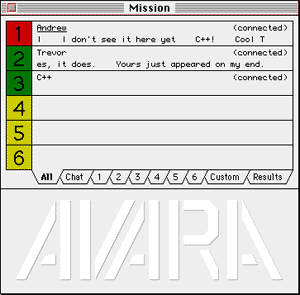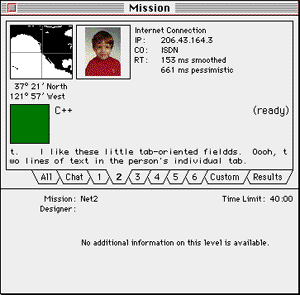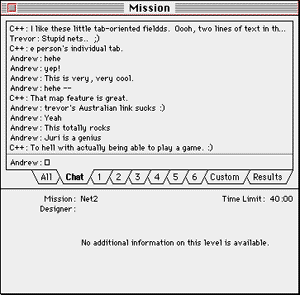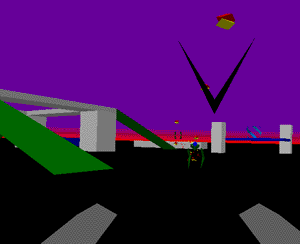Avara Update
by Andrew Welch
NOTE WELL: This product is still under development. This is a preview: everything mentioned here is subject to change without notice, because the product is a work in progress. Please don't ask us when it will be released -- that'll give us more time to finish the product and get it to you all that much sooner. We'll let you know just as soon as it is released, we promise. The best way to stay informed of product releases is to sign up for our announce_list mailing list, or check our web site periodically.
Assuming you have some kind of a connection to the Internet (and who doesn't these days?), Avara allows you to play with people from all over the world. Any time an Internet game of Avara is started, you have the option of notifying the "Avara Tracker" about the game.

The Avara Tracker is a program written by Matt Slot that runs on our SGI server. It's sole purpose is to keep track of current Avara games. To find out what games are currently in progress or waiting for opponents, Avara has a Query dialog box built right into the program that lets you do just this.

Chris Russo has also built a WWW interface to the Avara Tracker, so you can also check out what Avara games are active by using your favorite Web browser.
Of course, you can also play Avara on local AppleTalk or Ethernet networks as well. In fact, we hope that Avara will soon be used to settle grudge matches in companies and universities all over the world. Perhaps Juri will even win the Noble peace prize for his benevolent efforts?

Avara supports up to 6 people playing at any one time. From the Mission window, you can control who appears on what team. The person who started the Avara game is a "super user" who can control what the people joining his/her game can do.
For instance, you might want to be the one who decides who goes on what team, who can load maps, pause the game, etc.

The mission window has a unique tabbed interface that allows you to get all kinds of information on the people who are participating in a game. You can see a picture of the person (if they've supplied one), where in the world the are playing from, and their IP address.
Also, crucial to a game being played over the Internet, Avara gives a reasonably accurate indication of how fast each player's connection is. If someone is slowing you down, you can ask them to leave or find another game.

Part of playing any networked game is the interaction between other players, both on and off of the play field. Avara provides an excellent IRC or "chat room" style interface for conversing with other players both before and after the game.

Ah yes, the game. Here we see Andrew pelting "C++" with a shower of grenades, brilliantly blasting him into submission (an unbiased assessment of the situation, of course).

These screenshots are from one of Avara's collection of network levels. C++ is crouched down, ready to leap off of the building structure, attempting to escape just as Andrew gets a bead on 'im.

A unique aspect of Avara is that you can climb, jump, and run on any of the structures in the game. It's quite stunning to see players in the game walking in graceful strides on the play field, hurtling up ramps, swooping down from their hiding places with guns blazing, and then quickly diving for cover.

One of Avara's strengths is its flexibility. Avara levels are created through a combination of drawing objects in a drawing program such as ClarisWorks, and scripting the object interaction in a simple yet powerful object-oriented scripting language.
Avara provides a number of switches, powerups, objects, enemies, and structures for your imagination to build upon. You can design levels that range from slug-fests to Avara basketball (complete with anti-gravity fields near the baskets for flying slam dunks).

To build an Avara level, you draw the basic structure graphically, and then define the object interaction and other characteristics of the game in Avara's scripting language. While Avara's scripting language is easy to learn, it's also quite flexible. We're quite sure that people will be designing levels for Avara that do things we've never thought of, ensuring variety, diversity, and longevity in what is truly a unique game.


